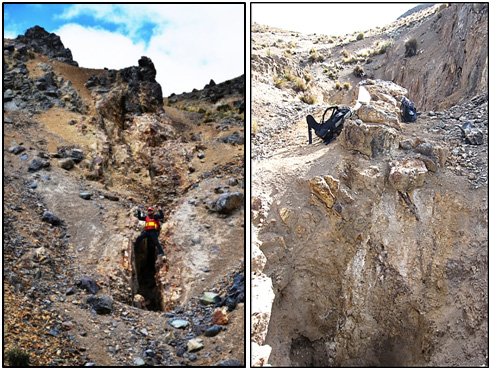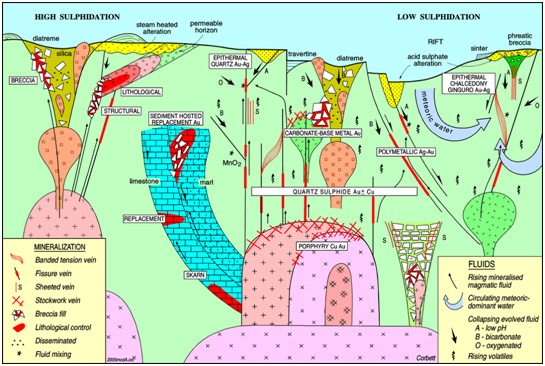The Huampar Project
The Huampar Project is located approximately 80 km NE (line of sight) from Lima Peru, in the southern portion of the Central Peruvian Polymetallic Belt. The project sits at altitudes between 4,000 and 4,500m ASL. Access to the property is via the Carretera Central, the principal highway servicing the central Andes, then unpaved secondary roads, a distance of about 160 kilometres by road from Lima.
The Project consists of multiple polymetallic veins on about 1,880 hectares (Ha) of concessions that contain 4 past producing mines. Historical production was between 100-250 tonnes per day (tpd), later ramped up to 350 tpd in the case of the Huampar Mine, which was developed to a maximum vertical depth of 450m below the surface. The Huampar site includes a decommissioned processing plant and camp facilities both of which requiring refurbishment. A historical tonnage and grade estimate was completed by MRDI (now AMEC Foster Wheeler) in 1999.
Trevali Agreement
Prism signed the definitive agreement with Trevali dated June 13, 2016 whereby Trevali must transfer 100% of the outstanding shares of its Peruvian subsidiary Nueva Condor S.A., 100% owner and holder of the Huampar property and associated mining rights for a consideration of $500,000 which was satisfied by the issuance of 5,750,000 common shares in Prism.
Trevali has the right to maintain its pro rata position in Prism
As a result of the transaction Mark Cruise became a board member of Prism Resources Inc.
Nueva Condor Agreement
The terms of the agreement with Nueva Condor include the following;
2,900,000 Prism common shares to CLM and 2 other individuals.
3% NSR of which 2% may be purchased in 1% tranches at any stage for payments of US$1.5 and US$2 million respectively within a period of two years from the approval date.
Annual payments of US$100,000 commencing on the second anniversary of the agreement which payments will be deductible from any NSR payments made to Nueva Condor.
Prism has retained the services of key Nueva Condor personnel for a monthly retainer fee of US$5,000 which fee will be capped at US$240,000 over a period of 4 years
The Huampar Project is located in the well-known Central Peruvian Polymetallic Belt of the Central Andes. The deposit is hosted exclusively in a volcanic sequence of rocks and consists of a series of polymetallic veins, with silver being the element of primary economic importance. Gold, zinc and lead all have lesser, but roughly equal economic importance. The veins outcrop on surface and have been previously mined to 450m below the surface.
There has been no modern exploration work completed such as geophysics and exploration diamond drilling as the veins are evident on surface, and historic mining generally started from vein outcrops. The technical work completed since the Trevali acquisition includes check underground sampling, surface geochemical sampling and some surface satellite based Aster and lineaments work. The majority of this work was completed in 2011 and 2012. The potential for substantial resources is good, both on known vein systems and potentially undiscovered veins.
Modern mining of several polymetallic veins began in 1956 and continued until 1991 when national electrical power shortages forced the mine to close. Production initially commenced at 100 to 250 tonnes per day (tpd) and processed approximately 2.5 million tonnes of ore with an average grade of 1.6 g/t Au, 185 g/t Ag, 3.8% Pb and 5.0% Zn. During this production period the reported recoveries were high and clean penalty free concentrates were produced. Mining continued intermittently from 1997 to late 1999 at approximately 350 tpd. Mining operations were suspended in 2000 due to low commodity prices.
The processing plant structure remains intact as does the camp and offices, but they all require updating, rehabilitation and reconstruction. Scoping level estimates have been made to refurbish the processing plant most recently in 2010. The underground has experienced mild water inundation and some rock falls. Pumping of the water and rehabilitation work will be required to create access for underground diamond drilling and to review the status of the development drives and older stopes in mineralized material.

Figure 1. Location map of Central Peru
Geology
The region is dominated by andesitic volcanic sequences. These include predominantly tuffs and massive flows interbedded that are variable in colour, texture and thickness. As well some dacitic bands are found in this pile. Minor siliceous and calcareous sedimentary interbeds are found below this volcanic sequence.
The Central Polymetallic Belt contains numerous styles of mineralization many of which have been mined since at least Spanish colonial time, including high-grade polymetallic (precious and base metal) vein systems (Huampar, Coricancha, Casapalca, Morococha), polymetallic carbonate replacement (Huanzala, Uchuchacua, Izcaycruz, Santander) and skarn deposits (Antamina, Magistral, Poderosa, Felicidad, Casapalca, Morococha) and copper porphyries (Toromocho).
The property is transected by several large scale (plus-5-km long) ENE-trending fracture zones. Structurally controlled mineralization is primarily hosted within sub-vertical, ENE-trending vein-fault systems. Mineralized veins typically have significant strike lengths (plus-1-km) and considerable depth potential (plus-800m).
There is also a late stage group of porphyritic dykes often following ENE trending fractures that are parallel to the mineralized veins.
Large areas of the valley bottoms are covered in very young alluvial deposits.

Figure 2. Geological map showing the Huampar property.
Huampar Project Mineralization
The principal Finlandia system is comprised of at least five major veins of variable widths ranging from 0.2-to-2.5 metres and averaging approximately 1-metre wide over an aggregate distance of approximately 5-kilometres strike length. The mineralization consists of zinc, lead, silver and gold. The Aurelio polymetallic vein system, approximately 2 km north of Finlandia, is a richer gold and silver vein system than Finlandia. It has an average width of 1 metre and a length of approximately 400 metres. The Condor Paso polymetallic vein system is located some 6 km south of the Finlandia and is traceable over a 2-km strike. All vein systems remain open for expansion.
Polymetallic precious and base metal mineralization is hosted in steeply dipping lateral and vertically extensive epithermal-mesothermal fault systems. Veins show multiple (at least five) stages of mineralization with variable sulphide mineral assemblages and gangue textures (colloform to coarse euhedral quartz). Principle minerals include coarse crystalline galena and sphalerite ± chalcopyrite and tetrahedrite. Gangue minerals are dominantly quartz ± pyrite, siderite with lesser amounts of barite, muscovite and cinnabar. Gold occurs as fine disseminations of free gold within both sulphides and quartz.
Mineralization was exploited using a combination of cut and fill and shrinkage mining methods from surface to depths ranging from 50-to-450 metres. Similar polymetallic mines in the district contain vertically continuous economic mineralization over intervals of 500-to-1000 metres suggesting good-to-excellent additional expansion potential at depth.

Figure 3. Photos of the Finlandia vein.
Deposit Type
The deposit type that has historically been mined is a series of intermediate sulfidation epithermal polymetallic veins in shears. These systems can frequently have long vertical and horizontal continuity.
Epithermal systems may be classified as high, intermediate, and low sulfidation styles. They are characterised by the sulfidation state of the hypogene sulfide mineral assemblage, and show general relations in volcanotectonic setting, precious and base metal content, igneous rock association, proximal hypogene alteration, and sulfide abundance (Sillitoe and Hedenquist, 2003). Ore in all occurrences of this type form under epizonal conditions, which is generally within 2 kilometres of the paleo-surface. Veins in epithermal systems often display textures indicative of repetitive and sustained open-space filling, and boiling.
The intermediate sulfidation terminology is where the hydrothermal fluids evolve from high to low sulfidation (Corbett, 2005).

Figure 4. Epithermal Deposit Model (from Corbett, 2005)
Vertical zonation in metal content occur in some low and intermediate sulfidation state systems. In systems displaying such zoning, gold, silver, mercury and tellurium are relatively enriched in the upper portions of the system, and base metal contents occur in higher concentrations at deeper levels in the system.
There is a potential at depth for replacement style mineralization in the underlying carbonate minerals but the focus of this present program is the depth extension of the previously mined vein systems within the volcanics.